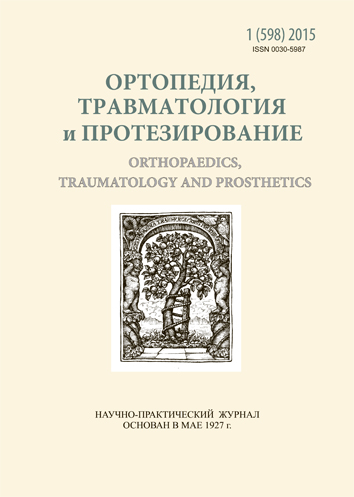Regeneration of long bone after implantation of β-tricalcium phosphate into its defect
DOI:
https://doi.org/10.15674/0030-59872015121-24Keywords:
ChronOS™, β-tricalcium phosphate, reparative osteogenesisAbstract
Purpose: in the defect of the rats' femoral shaft to investigate the rate of resorption of osteoplastic material сhronOS™, morphological features in adjacent to the site of implantation of the parent bone, quantitative and qualitative characteristics of the bone tissue regenerate and the nature of its interaction with the implant. Methods: The experiment was conducted on 12 white laboratory male rats (8 months, weight (250 ± 10) g). Under ketamine anesthesia in the middle third of the femoral shaft using a portable drill with spherical cutter at low speed with cooling we created defect diameter of 2.5 mm till the medullary canal which was filled with osteoplastic materials сhronOS™ (Synthes, Switzerland) in the shape of a block without any rigid fixation. Fragments of injured bones were examined after 60 and 120 days after implantation of сhronOS™ by methods of light microscopy with morphometry and scanning electron microscopy. Results: Maternal bones at all stages of observations revealed the presence of gaps with typical osteocytes which indicates a high biocompatibility with сhronOS™. In the area of the defect lamellar bone regenerate was detected which is represented by continuous fields with integrated into its structure recrement of osteoplastic material and separate growths of specific round shape with a high content of osteocytes and osteoblasts interconnected with one another. Growths of bone tissue corresponded in size and shape to pores of сhronOS™ which proves its osteoconductive properties. In micropores of сhronOS™ located osteogenic cells indicating their high affinity for osteoplastic materials. The ratio of the area of osteoplastic material and bone tissue on the 60th day of the experiment was (22,55 ± 1,21) and (77,45 ± 3,23) %, and on the 120th — (17,65 ± 1,09) and (82,3 ± 3,35) %, respectively.
References
- Arsenyev I.G. Experimentally-morphological study of clinical application of degradable Bioimplant in treatment of fractures and false joints of long bones: a thesis candidate. medical sciences: 14.00.22, 14.00.15 / Igor G. Arsenyev. - M., 2007. - 200 p.
- Grigoryan A. Problems of integration of implants in bone tissue (theoretical aspects) / A.S. Grigoryan, A.K. Toporkova. - M .: Technosphere, 2007. - 128 p.
- Lapach S.N. Statistical methods in biomedical research using Excel / S.N. Lapach, A.V. Hubenko, P.N. Babich. - Kiev: Morion, 2000. - 320 p.
- Paraskevich V.L. Dental implantology: Fundamentals of Theory and Practice / V.L. Paraskevich. - 3rd ed. - M .: LLC "Medical News Agency", 2011. - 400 ..
- D.S. Sarkisov The microscopic technique / D.S. Sarkisov, Yu. L. Perov. - M .: Medicine, 1996. - 542 p.
- Behaviour of СhronOs™ inject in metaphyseal bone defects of distal radius fractures: tissue reaction after 6–15 months / R. Arora, S. Milz, C. Sprecher [et. all.] // Injury. — 2012. — Vol. 43(10) — P. 1683–1688, doi: 10.1016/j.injury.2012.06.006.
- β-Tricalcium phosphate as a bone substitute for-dorsal spinal fusion in adolescent idiopathic scoliosis — preliminary result of a prospective clinical study / M. Muschik, R. Ludwig, S. Halbhubner [et al.] //Eur Spine J. — 2001. — Vol. 10(2). — P. 178–184.
- β-TCP bone graft substitutes in a bilateral rabbit tibial defect model / W. R. Walsh, F. Vizesi, D. Michael [et al.] // Biomaterials. — 2008. — Vol. 29(3). — P. 266–271.
- Pochon J. P. Knochenersatzplastiken mit Tricalciumphosphatkeramik im Kindesalter / J. P. Pochon // Aktuelle Probleme in Chirurgie und Orthopadie. — 1990. — Vol. 36. — P. 146.
- Steffen T. Porous tricalcium phosphate and transforming growth factor used for anterior spine surgery / T. Steffen, T. Stoll, T. Arvinte // Eur. Spine J. — 2001. — Vol. 10, Suppl. 2. — P. S132–S140.
- Stoll T. New aspects in osteoinduction / T. Stoll // Mat. Sci. Eng. Tech. — 2004. — Vol. 35 (4). — P. 198–202, doi: 10.1002/mawe.200400738.
- Tricalcium phosphate granules or rigid wedge preforms in open wedge high tibial osteotomy: a radiological study with a new evaluation system / W. L. van Hemert, K. Willems, P. G. Anderson [et al.] // Knee. — 2004. — Vol. 11(6). — P. 451–456.
- Wheeler D. Grafting of massive tibial subchondral bone defects in a caprine model using — tricalcium phosphate versus autograft / D. Wheeler // J. Orthop. Trauma. — 2005. — Vol. 19(2). — P. 85–91.
Downloads
How to Cite
Issue
Section
License
Copyright (c) 2015 Olexiy Korenkov

This work is licensed under a Creative Commons Attribution 4.0 International License.
The authors retain the right of authorship of their manuscript and pass the journal the right of the first publication of this article, which automatically become available from the date of publication under the terms of Creative Commons Attribution License, which allows others to freely distribute the published manuscript with mandatory linking to authors of the original research and the first publication of this one in this journal.
Authors have the right to enter into a separate supplemental agreement on the additional non-exclusive distribution of manuscript in the form in which it was published by the journal (i.e. to put work in electronic storage of an institution or publish as a part of the book) while maintaining the reference to the first publication of the manuscript in this journal.
The editorial policy of the journal allows authors and encourages manuscript accommodation online (i.e. in storage of an institution or on the personal websites) as before submission of the manuscript to the editorial office, and during its editorial processing because it contributes to productive scientific discussion and positively affects the efficiency and dynamics of the published manuscript citation (see The Effect of Open Access).














